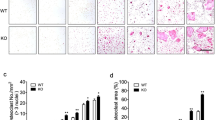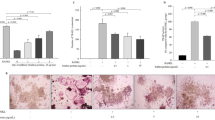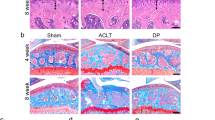Abstract
In chronic infectious diseases caused by gram-negative bacteria, such as osteomyelitis, septic arthritis, and periodontitis, osteoclastic activity is enhanced with elevated inflammation, which disturbs the bone homeostasis and results in osteolysis. Lipopolysaccharide (LPS), as a bacteria product, plays an important role in this process. Recent evidence shows that an antimalarial drug artesunate attenuates LPS-induced osteolysis independent of RANKL. In this study we evaluated the effects of artesunate on LPS-induced osteoclastogenesis in vitro and femur osteolysis in vivo, and explored the mechanisms underlying the effects of artesunate on LPS-induced osteoclast differentiation independent of RANKL. In preosteoclastic RAW264.7 cells, we found that artesunate (1.56−12.5 μM) dose dependently inhibited LPS-induced osteoclast formation accompanied by suppressing LPS-stimulated osteoclast-related gene expression (Fra-2, TRAP, Cathepsin K, β3-integrin, DC-STAMP, and Atp6v0d2). We showed that artesunate (3.125−12.5 µM) inhibited LPS-stimulated nuclear factor of activated T cells c1 (NFATc1) but not NF-κB transcriptional activity; artesunate (6.25, 12.5 μM) significantly inhibited LPS-stimulated NFATc1 protein expression. Furthermore, artesunate treatment markedly suppressed LPS-induced Ca2+ influx, and decreased the expression of PP2B-Aα (calcineurin) and pPLCγ1 in the cells. In addition, artesunate treatment significantly decreased the expression of upstream signals TLR4 and TRAF6 during LPS-induced osteoclastogenesis. Administration of artesunate (10 mg/kg, ip) for 8 days effectively inhibited serum TNF-α levels and ameliorated LPS (5 mg/kg, ip)-induced inflammatory bone loss in vivo. Taken together, artesunate attenuates LPS-induced inflammatory osteoclastogenesis by inhibiting the expression of TLR4/TRAF6 and the downstream PLCγ1-Ca2+-NFATc1 signaling pathway. Artesunate is a valuable choice to treat bone loss induced by gram-negative bacteria infection or inflammation in RANKL-independent pathway.
Similar content being viewed by others
Log in or create a free account to read this content
Gain free access to this article, as well as selected content from this journal and more on nature.com
or
References
Zhao C, Irie N, Takada Y, Shimoda K, Miyamoto T, Nishiwaki T, et al. Bidirectional ephrinB2-EphB4 signaling controls bone homeostasis. Cell Metab. 2006;4:111–21.
Nair SP, Meghji S, Wilson M, Reddi K, White P, Henderson B. Bacterially induced bone destruction: mechanisms and misconceptions. Infect Immun. 1996;64:2371–80.
Keestra JAJ, Grosjean I, Coucke W, Quirynen M, Teughels W. Non‐surgical periodontal therapy with systemic antibiotics in patients with untreated aggressive periodontitis: a systematic review and meta‐analysis. J Periodontal Res. 2014;50:689–706.
Bohannon JK, Hernandez A, Enkhbaatar P, Adams WL, Sherwood ER. The immunobiology of toll-like receptor 4 agonists: from endotoxin tolerance to immunoadjuvants. Shock. 2013;40:451–62.
Suda K, Udagawa N, Sato N, Takami M, Itoh K, Woo JT, et al. Suppression of osteoprotegerin expression by prostaglandin E2 is crucially involved in lipopolysaccharide-induced osteoclast formation. J Immunol. 2004;172:2504–10.
Islam S, Hassan F, Tumurkhuu G, Dagvadorj J, Koide N, Naiki Y, et al. Bacterial lipopolysaccharide induces osteoclast formation in RAW 264.7 macrophage cells. Biochem Biophys Res Commun. 2007;360:346–51.
Hotokezaka H, Sakai E, Ohara N, Hotokezaka Y, Gonzales C, Matsuo K, et al. Molecular analysis of RANKL‐independent cell fusion of osteoclast‐like cells induced by TNF‐α, lipopolysaccharide, or peptidoglycan. J Cell Biochem. 2006;101:122–34.
He L, Duan H, Li X, Wang S, Zhang Y, Lei L, et al. Sinomenine down-regulates TLR4/TRAF6 expression and attenuates lipopolysaccharide-induced osteoclastogenesis and osteolysis. Eur J Pharmacol. 2016;779:66–79.
Khuda II, Koide N, Noman AS, Dagvadorj J, Tumurkhuu G, Naiki Y, et al. Seladin‐1 is a novel lipopolysaccharide (LPS)‐responsive gene and inhibits the tumour necrosis factor-α production and osteoclast formation in response to LPS. Immunology. 2010;131:59–66.
Guo C, Hou GQ, Li XD, Xia X, Liu DX, Huang DY, et al. Quercetin triggers apoptosis of lipopolysaccharide (LPS)-induced osteoclasts and inhibits bone resorption in RAW264.7 cells. Cell Physiol Biochem. 2012;30:123–36.
Hou GQ, Guo C, Song GH, Fang N, Fan WJ, Chen XD, et al. Lipopolysaccharide (LPS) promotes osteoclast differentiation and activation by enhancing the MAPK pathway and COX-2 expression in RAW264.7 cells. Int J Mol Med. 2013;32:503–10.
Park H, Noh AL, Kang JH, Sim JS, Lee DS, Yim M. Peroxiredoxin II negatively regulates lipopolysaccharide-induced osteoclast formation and bone loss via JNK and STAT3. Antioxid Redox Signal. 2015;22:63–77.
Rosenthal PJ. Artesunate for the treatment of severe falciparum malaria. N Engl J Med. 2008;358:1829–36.
Ho WE, Peh HY, Chan TK, Wong WS. Artemisinins: pharmacological actions beyond anti-malarial. Pharmacol Ther. 2014;142:126–39.
Zhao C, Liu Q, Wang K. Artesunate attenuates ACLT-induced osteoarthritis by suppressing osteoclastogenesis and aberrant angiogenesis. Biomed Pharmacother. 2017;96:410–6.
Zeng X, Zhang Y, Wang S, Wang K, Tao L, Zou M, et al. Artesunate suppresses RANKL-induced osteoclastogenesis through inhibition of PLCγ1-Ca2+–NFATc1 signaling pathway and prevents ovariectomy-induced bone loss. Biochem Pharmacol. 2017;124:57–68.
Wei CM, Liu Q, Song FM, Lin XX, Su YJ, Xu J, et al. Artesunate inhibits RANKL‐induced osteoclastogenesis and bone resorption in vitro and prevents LPS‐induced bone loss in vivo. J Cell Physiol. 2017;233:476–85.
Thummuri D, Jeengar MK, Shrivastava S, Nemani H, Ramavat RN, Chaudhari P, et al. Thymoquinone prevents RANKL-induced osteoclastogenesis activation and osteolysis in an in vivo model of inflammation by suppressing NF-κB and MAPK Signalling. Pharmacol Res. 2015;99:63–73.
Boyle WJ, Simonet WS, Lacey DL. Osteoclast differentiation and activation. Nature. 2003;423:337–42.
Ye F, Zhou Q, Tian L, Lei F, Feng D. The protective effect of berberine hydrochloride on LPS‑induced osteoclastogenesis through inhibiting TRAF6‑Ca2+‑calcineurin‑NFATc1 signaling pathway. Mol Med Rep. 2017;16:6228–33.
Yoon SH, Lee Y, Kim HJ, Lee ZH, Hyung SW, Lee SW, et al. Lyn inhibits osteoclast differentiation by interfering with PLCgamma1-mediated Ca2+ signaling. FEBS Lett. 2009;583:1164–70.
He A, Ji R, Shao J, He C, Jin M, Xu Y. TLR4-MyD88-TRAF6-TAK1 complex-mediated NF-kappaB activation contribute to the anti-inflammatory effect of V8 in LPS-induced human cervical cancer SiHacells. Inflammation. 2016;39:172–81.
Rodan GA, Martin TJ. Therapeutic approaches to bone diseases. Science. 2000;289:1508–14.
Zhang Y, Yan M, Yu QF, Yang PF, Zhang HD, Sun YH, et al. Puerarin prevents LPS-induced osteoclast formation and bone loss via inhibition of Akt activation. Biol Pharm Bull. 2016;39:2028–35.
Abu-Amer Y, Ross FP, Edwards J, Teitelbaum SL. Lipopolysaccharide-stimulated osteoclastogenesis is mediated by tumor necrosis factor via its P55 receptor. J Clin Investig. 1997;100:1557–65.
Takayanagi H, Kim S, Koga T, Nishina H, Isshiki M, Yoshida H, et al. Induction and activation of the transcription factor NFATc1 (NFAT2) integrate RANKL signaling in terminal differentiation of osteoclasts. Dev Cell. 2002;3:889–901.
Zhou L, Liu Q, Yang M, Wang T, Yao J, Cheng J, et al. Dihydroartemisinin, an anti‐malaria drug, suppresses estrogen deficiency‐induced osteoporosis, osteoclast formation, and RANKL‐induced signaling pathways. J Bone Miner Res. 2016;31:964–74.
Asagiri M, Takayanagi H. The molecular understanding of osteoclast differentiation. Bone. 2007;40:251–64.
Cen Y, Liu C, Li X, Yan Z, Kuang M, Su Y, et al. Artesunate ameliorates severe acute pancreatitis (SAP) in rats by inhibiting expression of pro-inflammatory cytokines and Toll-like receptor 4. Int Immunopharmacol. 2016;38:252–60.
Yang M, Guo MY, Luo Y, Yun MD, Yan J, Liu T, et al. Effect of Artemisia annua extract on treating active rheumatoid arthritis: a randomized controlled trial. Chin J Integr Med. 2017;23:496–503.
Lee EY, Seo M, Juhnn YS, Kim JY, Hong YJ, Lee YJ, et al. Potential role and mechanism of IFN-gamma inducible protein-10 on receptor activator of nuclear factor kappa-B ligand (RANKL) expression in rheumatoid arthritis. Arthritis Res Ther. 2011;13:R104.
Acknowledgements
This work was supported by the National Natural Science Foundation of China (81773740, 81073119, and 81611130078), the Natural Science Foundation of Guangdong Province, China (2015A030313287), and the Natural Science Foundation of Hainan Province, China (817129).
Author information
Authors and Affiliations
Contributions
XJL, XZZ and SWL designed the research; XZZ, YYZ, QY, SW, BHZ and YHT performed the research; XZZ, SW and MZ analyzed the data; XZZ, QY, XJL and SWL wrote the paper.
Corresponding authors
Ethics declarations
Competing interests
The authors declare no competing interests.
Additional information
Chemical compounds studied in this article: artesunate (PubChem CID: 16394563); cyclosporin A (CsA) (PubChem CID: 5284373); BAY11-7082 (PubChem CID: 5353431).
Rights and permissions
About this article
Cite this article
Zeng, Xz., Zhang, Yy., Yang, Q. et al. Artesunate attenuates LPS-induced osteoclastogenesis by suppressing TLR4/TRAF6 and PLCγ1-Ca2+-NFATc1 signaling pathway. Acta Pharmacol Sin 41, 229–236 (2020). https://doi.org/10.1038/s41401-019-0289-6
Received:
Accepted:
Published:
Issue date:
DOI: https://doi.org/10.1038/s41401-019-0289-6
Keywords
This article is cited by
-
Sinensetin serves as an AMPK activator to inhibit RANKL-induced osteoclastogenesis via osteoclast cytoskeleton reorganization
Journal of Translational Medicine (2025)
-
TREM2 Modulates Postoperative Cognitive Function in Aged Mice by Inhibiting the NLRP3/caspase-1 Pathway and Apoptosis via PLCγ2 Activation
Molecular Neurobiology (2025)
-
Chitosan-Artesunate nanoparticles: A dual anti-fibrotic and anti-inflammatory strategy for preventing bleb fibrosis post-glaucoma filtration surgery
Drug Delivery and Translational Research (2025)
-
Melatonin attenuates inflammatory bone loss by alleviating mitophagy and lactate production
Apoptosis (2025)
-
Artesunate-loaded thermosensitive chitosan hydrogel promotes osteogenesis of maxillary tooth extraction through regulating T lymphocytes in type 2 diabetic rats
BMC Oral Health (2024)



